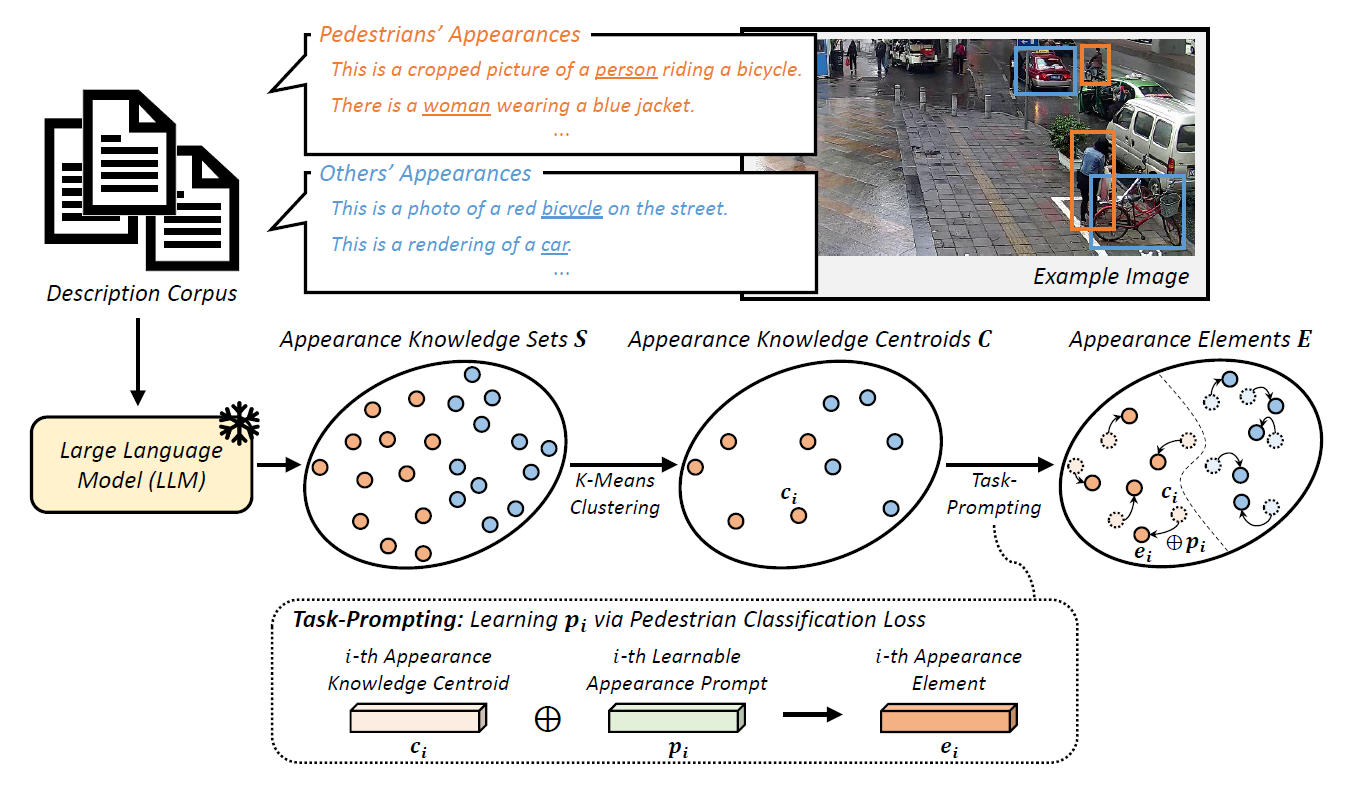By Sungjune Park*, Hyunjun Kim*, and Yong Man Ro†
*Both authors contributed equally
 Large language models (LLMs) have shown their capability in understanding contextual and semantic information regarding appearance knowledge of instances. In this paper, we introduce a novel approach to utilize the strength of an LLM in understanding contextual appearance variations and to leverage its knowledge into a vision model (here, pedestrian detection). While pedestrian detection is considered one of crucial tasks directly related with our safety (e.g., intelligent driving system), it is challenging because of varying appearances and poses in diverse scenes. Therefore, we propose to formulate language-driven appearance knowledge units and incorporate them with visual cues in pedestrian detection. To this end, we establish description corpus which includes numerous narratives describing various appearances of pedestrians and others. By feeding them through an LLM, we extract appearance knowledge sets that contain the representations of appearance variations. After that, we perform a task-prompting process to obtain appearance knowledge units which are representative appearance knowledge guided to be relevant to a downstream pedestrian detection task. Finally, we provide plentiful appearance information by integrating the language-driven knowledge units with visual cues. Through comprehensive experiments with various pedestrian detectors, we verify the effectiveness of our method showing noticeable performance gains and achieving state-of-the-art detection performance.
Large language models (LLMs) have shown their capability in understanding contextual and semantic information regarding appearance knowledge of instances. In this paper, we introduce a novel approach to utilize the strength of an LLM in understanding contextual appearance variations and to leverage its knowledge into a vision model (here, pedestrian detection). While pedestrian detection is considered one of crucial tasks directly related with our safety (e.g., intelligent driving system), it is challenging because of varying appearances and poses in diverse scenes. Therefore, we propose to formulate language-driven appearance knowledge units and incorporate them with visual cues in pedestrian detection. To this end, we establish description corpus which includes numerous narratives describing various appearances of pedestrians and others. By feeding them through an LLM, we extract appearance knowledge sets that contain the representations of appearance variations. After that, we perform a task-prompting process to obtain appearance knowledge units which are representative appearance knowledge guided to be relevant to a downstream pedestrian detection task. Finally, we provide plentiful appearance information by integrating the language-driven knowledge units with visual cues. Through comprehensive experiments with various pedestrian detectors, we verify the effectiveness of our method showing noticeable performance gains and achieving state-of-the-art detection performance.
| Method | #queries | box AP(val) |
|---|---|---|
| Sparse R-CNN | 500 | 90.7 |
| D-DETR | 1000 | 91.5 |
| E2EDET (Sparse R-CNN) | 500 | 92.0 |
| E2EDET (D-DETR) | 1000 | 92.1 |
| DRFG + PMIP | - | 92.2 |
| Deng et al | 500 | 92.3 |
| DDQ R-CNN | 300 | 93.5 |
| DDQ DETR | 900 | 94.8 |
| Ours (Sparse R-CNN) | 500 | 92.6 |
| Ours (D-DETR) | 1000 | 94.2 |
| Ours (DDQ R-CNN) | 300 | 94.5 |
| Ours (DDQ DETR) | 900 | 95.4 |
Our project has been fully tested under torch 1.9.0+cu111, you can install from pytorch official website.
pip install -r requirements.txt
cd mmcv-1.4.7
MMCV_WITH_OPS=1 python setup.py build_ext --inplace
ln -s mmcv-1.4.7/mmcv ./
cd ..
export PYTHONPATH=`pwd`:$PYTHONPATHLDAE
├── data
│ ├── crowdhuman
│ │ ├── annotations
│ │ │ ├──annotation_train.json
│ │ │ ├──annotation_val.json
│ │ ├── train
│ │ ├── val
We provide unofficial annotations in .json format for CrowdHuman already contained in the repository data/crowdhuman/annotations/, which are used in the previous works, such as Pedestron.
Evaluate LDAE with ddq-rcnn. You can download the pre-trained model from here for direct evaluation.
sh tools/test.sh projects/configs/LDAE_rcnn/rcnn_LDAE.py <path_to_checkpoint> 8 --eval bboxyou can have evaluation result: {'bbox_mAP': 94.5, 'mMR': 38.5, 'recall': 98.4}
Data preparation and training code will be updated as soon as organized.
Our code is based on mmdetection and ddq-rcnn. Thank you for these exceptional contributions to the field.
Please cite our paper in your publications if it helps your research:
@article{park2023incorporating,
title={Incorporating Language-Driven Appearance Knowledge Units with Visual Cues in Pedestrian Detection},
author={Park, Sungjune and Kim, Hyunjun and Ro, Yong Man},
journal={arXiv preprint arXiv:2311.01025},
year={2023}
}